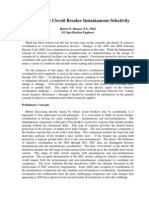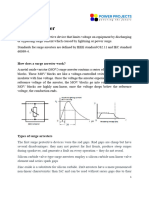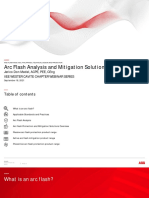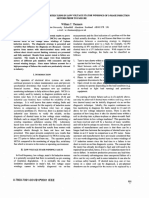15-Chapter 4 Short Circuit Analysis-Objectives and Methodology
15-Chapter 4 Short Circuit Analysis-Objectives and Methodology
Uploaded by
Ryan Anthony UmaliCopyright:
Available Formats
15-Chapter 4 Short Circuit Analysis-Objectives and Methodology
15-Chapter 4 Short Circuit Analysis-Objectives and Methodology
Uploaded by
Ryan Anthony UmaliOriginal Description:
Copyright
Available Formats
Share this document
Did you find this document useful?
Is this content inappropriate?
Copyright:
Available Formats
15-Chapter 4 Short Circuit Analysis-Objectives and Methodology
15-Chapter 4 Short Circuit Analysis-Objectives and Methodology
Uploaded by
Ryan Anthony UmaliCopyright:
Available Formats
CHAPTER 4- SHORT CIRCUIT STUDY
4.1 Objectives
The objectives of this study are
1. Evaluate the short circuit current ratings of protection devices
a. Close and Latch (Making) rating of MV circuit breakers
b. Interrupting (Breaking) rating of the MV and LV circuit
breakers
c. Short Circuit rating of the bus bars
d. Sizing of the Equipment Grounding Conductors and the
Grounding Electrode Conductors for power transformers
2. In order to perform the evaluation of devices, short circuit
calculation for both Momentary Networks and Interrupting
Networks will be performed for
a. Balanced 3-phase Faults
b. Single Line to Ground Faults
c. Line to Line Faults
d. Double Line to Ground Faults
3. Provide recommendations based on the evaluation
4.2 Methodology
According to Philippine Electrical Code Part 1 2009 Article
1.10.1.9, Interrupting Rating Equipment intended to interrupt
current at fault levels shall have an interrupting rating sufficient for
the nominal circuit voltage and the current that is available at the
line terminals of the equipment. Therefore a short circuit study is
essential in properly selecting the interrupting and making capacity
of circuit breakers and fuses.
Fault points are selected such that the short circuit occur on
the
immediate
vicinity
of
the
downstream
terminals
of
the
protection equipment and is summarized on the table 4.1.
Chapter 4-Short Circuit Calculation
Page 182
Table 4.1 Summary of Fault Points
Fault
Point
F1
Fault Location
Fault Type
Networks
Bolted-3ph,SLG,
LL, DLG
Momentary,
Interrupting
F3
13.8kV Power Plant Bus
and downstream of
BAC908
Primary terminals of
TRM1
6.9kV switchgear (bus)
F4
Primary terminals TRL3A
F5
Primary terminals TRL3B
F6
MCC8 Bus
Momentary,
Interrupting
Momentary,
Interrupting
Momentary,
Interrupting
Momentary,
Interrupting
Momentary
F7
MCC9 Bus
F8
PE-KM5806 Terminals
F9
PE-YM7601 Terminals
F10
PE-KM8639 Terminals
F11
PE-KM8601 Terminals
F12
PC001 Terminals
F13
GM1412 Terminals
F14
GM1413 Terminals
F15
KM5814 Terminals
F16
GM8103A Terminals
F17
GM8103S Terminals
F18
MNDB Terminals
F19
EMBD Terminals
F20
YM7607 Terminals
F21
SM8645 Terminals
Bolted-3ph,SLG,
LL, DLG
Bolted-3ph,SLG,
LL, DLG
Bolted-3ph,SLG,
LL, DLG
Bolted-3ph,SLG,
LL, DLG
Bolted-3ph,SLG,
LL, DLG
Bolted-3ph,SLG,
LL, DLG
Bolted-3ph,SLG,
LL, DLG
Bolted-3ph,SLG,
LL, DLG
Bolted-3ph,SLG,
LL, DLG
Bolted-3ph,SLG,
LL, DLG
Bolted-3ph,SLG,
LL, DLG
Bolted-3ph,SLG,
LL, DLG
Bolted-3ph,SLG,
LL, DLG
Bolted-3ph,SLG,
LL, DLG
Bolted-3ph,SLG,
LL, DLG
Bolted-3ph,SLG,
LL, DLG
Bolted-3ph,SLG,
LL, DLG
Bolted-3ph,SLG,
LL, DLG
Bolted-3ph,SLG,
LL, DLG
Bolted-3ph,SLG,
F2
Chapter 4-Short Circuit Calculation
Momentary
Momentary
Momentary
Momentary
Momentary
Momentary
Momentary
Momentary
Momentary
Momentary
Momentary
Momentary
Momentary
Momentary
Momentary
Page 183
F22
GM7612 Terminals
F23
7601M1 Terminals
F24
KM8607 Terminals
LL, DLG
Bolted-3ph,SLG,
LL, DLG
Bolted-3ph,SLG,
LL, DLG
Bolted-3ph,SLG,
LL, DLG
Momentary
Momentary
Momentary
F1 is a fault point occurring just downstream of BAC 908
breaker while F2 is fault on High voltage terminal of TRM1. F3, F4
and F5 are fault points on 6.9kV buses while F6 and F7 are fault
points on 480V buses. F8 up to F24 are fault points on critical 480V
loads.
This study will use the detailed recommendations from
7
IEEE Std. 551-2006 Violet Book for calculating the fault currents
and evaluation of equipment ratings as well as ANSI IEEE 8C37.0101999. The calculations will have two major parts namely Momentary
Short circuit calculations and Interrupting short circuit calculations.
Both
momentary
and
interrupting
calculation
will
be
performed. With each calculation, the three phase fault, single line
to ground fault, line to line fault and double line to ground fault will
be calculated. Generally, the E/Z method will be used while
separate X and R network reduction will be utilized to calculate the
X/R ratio at fault point necessary in determining the AC and DC
decrement factors.
IEEE Std. 551-2006 Violet Book Recommended Practice for Calculating ShortCircuit Currents in Industrial and Commercial Power Systems, Chapter 9
8
IEEE Application Guide for AC High-Voltage Circuit Breakers Rated on
Symmetrical Current Basis
Chapter 4-Short Circuit Calculation
Page 184
Table 4.2 Protection Device Short Circuit Rating Evaluation
Summary
SHORT
LV
CIRCUIT
POWER FUSE
MV VCB
LV ACB
MCC
CURRENT
B
I
Rated
MOM,SYM, Interrupting
RMS
Capacity
I
Rated
Rated Making
MOM,ASY
Asymmetrical
(Peak) or
Rated Interrupting
M,PEAK
Interrupting Peak C&L
I
Rated
MOM,ASY
Asymmetrical
M,RMS
Interrupting RMS
I
Rated
INT,ASYM,
Interrupting
RMS
capacity
It should be clearly noted that motors driven by PWM type
VFD are not expected to contribute fault current and therefore not
included in the short circuit impedance network. This is due to the
fact that in standard PWM VFD, no energy can transferred back to
the ac line since the overvoltage condition forces the input rectifier
section of the drive into an off or non-conducting state.
For Capacitor bank, since each capacitor is installed with a
current limiting reactor, the contribution of capacitor during short
circuit condition is also neglected. Moreover, IEEE Violet Book
recommends the exclusion of capacitor contribution on short circuit
studies9.
IEEE Std. 551-2006 Violet Book Recommended Practice for Calculating ShortCircuit Currents in Industrial and Commercial Power Systems, Section 7.4, p165
Chapter 4-Short Circuit Calculation
Page 185
You might also like
- LAPTOP POWER Sequence Training 1.0.0 PDFDocument52 pagesLAPTOP POWER Sequence Training 1.0.0 PDFrmartins_23947487% (60)
- Broken PGE - Standard Values For AICDocument3 pagesBroken PGE - Standard Values For AICBrandon ChoateNo ratings yet
- Trip Relay & Opto Input Immunity Issue V1Document23 pagesTrip Relay & Opto Input Immunity Issue V1Neelakandan Masilamani100% (1)
- Pec ReviewerDocument1 pagePec ReviewerRyan Anthony UmaliNo ratings yet
- 29-Chapter 5 Protection Coordination-Objectives and Methodology Part 2Document14 pages29-Chapter 5 Protection Coordination-Objectives and Methodology Part 2Ryan Anthony Umali100% (1)
- SMAW FinalsDocument4 pagesSMAW FinalsIan Asperga100% (1)
- 1vga671048 - Internal Arc Containment, Resistance and Arc Flash MitigationDocument6 pages1vga671048 - Internal Arc Containment, Resistance and Arc Flash MitigationdienlangchuNo ratings yet
- Enhanced With Multiple Language Support: Modules (Enhanced) Templates One-Line DiagramDocument2 pagesEnhanced With Multiple Language Support: Modules (Enhanced) Templates One-Line Diagramrasim_m1146No ratings yet
- Etap - Key Points For Load Summary, Part 4: Lumped Load ApplicationsDocument2 pagesEtap - Key Points For Load Summary, Part 4: Lumped Load ApplicationsMarcelNo ratings yet
- ARC Flash KPI Compliance at A Large Oil and Gas CompanyDocument6 pagesARC Flash KPI Compliance at A Large Oil and Gas CompanySamara FahiraNo ratings yet
- Burden Calculation of 33kV Outgoing Feeder SK Vita-2 CT Secondary Circuit of at Jamalpur 132/33 KV Grid SubstationDocument3 pagesBurden Calculation of 33kV Outgoing Feeder SK Vita-2 CT Secondary Circuit of at Jamalpur 132/33 KV Grid SubstationRajnarayan KarmakerNo ratings yet
- Techniacl Paper - Arc Flash Analysis - SummaryDocument6 pagesTechniacl Paper - Arc Flash Analysis - SummaryFady El HindawyNo ratings yet
- Energy Reduction Maintenance Setting (ERMS) Switch - 120816 WEBDocument4 pagesEnergy Reduction Maintenance Setting (ERMS) Switch - 120816 WEBVigneshwaran KandaswamyNo ratings yet
- Demand FactorDocument5 pagesDemand FactorJanitha HettiarachchiNo ratings yet
- (LS) LV SWGR Power Center e 1304 1Document20 pages(LS) LV SWGR Power Center e 1304 1Wonbae ChoiNo ratings yet
- ArcFlash Example1-SolutionDocument8 pagesArcFlash Example1-SolutionJavier Madrigal OviedoNo ratings yet
- Out-Of-step Protection For Generators GER-3179Document28 pagesOut-Of-step Protection For Generators GER-3179robertoseniorNo ratings yet
- ArcFlash Example4 PDFDocument7 pagesArcFlash Example4 PDFashraf-84No ratings yet
- Arc FlashDocument24 pagesArc FlashKVRamananNo ratings yet
- Webinar 19 - Arc Flash ProtectionDocument97 pagesWebinar 19 - Arc Flash ProtectionFranz Xyrlo Ibarra TobiasNo ratings yet
- Alumoweld Overhead Ground Wire CharacteristicsDocument2 pagesAlumoweld Overhead Ground Wire Characteristicsdowner52No ratings yet
- Cable Damage CurveDocument3 pagesCable Damage CurveMark-Honey Boquiron Delos ReyesNo ratings yet
- Arc FlashDocument10 pagesArc FlashVictor Manuel Flores ZuñigaNo ratings yet
- Overcurrent Coordination Setting Guidelines CapacitorsDocument4 pagesOvercurrent Coordination Setting Guidelines CapacitorsrobertoseniorNo ratings yet
- EL07 Coordination System of Low Voltage Circuit Breaker - PresentationDocument39 pagesEL07 Coordination System of Low Voltage Circuit Breaker - PresentationJhonSitanala100% (2)
- Arc FlashDocument26 pagesArc Flashmohamed_elhadadNo ratings yet
- Designing For Circuit Breaker Instantaneous SelectivityDocument9 pagesDesigning For Circuit Breaker Instantaneous Selectivityparrilla506No ratings yet
- 2012Ch1 Supple NotesDocument12 pages2012Ch1 Supple Noteskhaldoun samiNo ratings yet
- Report 2Document96 pagesReport 2ramvinod1950No ratings yet
- Etap Csi New Specification TemplateDocument13 pagesEtap Csi New Specification Templaterambliagusti5No ratings yet
- 29-Chapter 6 Detailed Motor Starting PDFDocument14 pages29-Chapter 6 Detailed Motor Starting PDFRyan Anthony UmaliNo ratings yet
- Max Earth Fault Loop Impedance Values For Overcurrent ProtectiveDocument1 pageMax Earth Fault Loop Impedance Values For Overcurrent ProtectiveRa ArNo ratings yet
- Upf MythDocument3 pagesUpf MythgurbachansainiNo ratings yet
- Annexure-17 Fault Ride Through Functions - LVRT HVRT & ZVRT - DelCEN 2500 HV PDFDocument2 pagesAnnexure-17 Fault Ride Through Functions - LVRT HVRT & ZVRT - DelCEN 2500 HV PDFSAEL SOLARNo ratings yet
- Surge Arrester SizingDocument3 pagesSurge Arrester Sizingoadipphone7031100% (1)
- An Over-View of Power Quality: Akash Kewal RamDocument27 pagesAn Over-View of Power Quality: Akash Kewal RamDina Garan100% (1)
- Selective Coordination Breaker Application ChartDocument5 pagesSelective Coordination Breaker Application Charthanner90No ratings yet
- IIEE-NCC GMM - Power Quality - VFPelagoDocument56 pagesIIEE-NCC GMM - Power Quality - VFPelagoJellyn BaseNo ratings yet
- ReadmeDocument49 pagesReadmeSudah Sirnakah SemuaNo ratings yet
- Arc Flash Analysis and Mitigation Solutions - IIEE WCCDocument155 pagesArc Flash Analysis and Mitigation Solutions - IIEE WCCJake Lozanta100% (1)
- Differences Between Earthed and Unearthed Cables - EEPDocument5 pagesDifferences Between Earthed and Unearthed Cables - EEPAnil MarturiNo ratings yet
- Arc Flash Rev 02 STL Power SolutionDocument47 pagesArc Flash Rev 02 STL Power Solutionalf sunflowerNo ratings yet
- Surge Protection Over Voltage DevicesDocument24 pagesSurge Protection Over Voltage Devicesnooruddinkhan1No ratings yet
- Motor ProtectionDocument33 pagesMotor ProtectionMohamed RashidNo ratings yet
- Working of Auxiliary CTDocument1 pageWorking of Auxiliary CTLokesh BabuNo ratings yet
- Arc Flash Exercise 1: Purpose & DescriptionDocument5 pagesArc Flash Exercise 1: Purpose & DescriptionLiliana ParadaNo ratings yet
- Protection Relay - ANSI Standards - EEPDocument10 pagesProtection Relay - ANSI Standards - EEPmuraliNo ratings yet
- Etap GettingstartedDocument125 pagesEtap GettingstartedSeriNo ratings yet
- Power Circuit BreakersDocument83 pagesPower Circuit BreakersAhmad HamoudaNo ratings yet
- IP Rating - What Does It Mean?: IP Stands For Ingress ProtectionDocument1 pageIP Rating - What Does It Mean?: IP Stands For Ingress Protectionjasmin_patel_27No ratings yet
- An Overview of Short Circuit Current Part 2Document4 pagesAn Overview of Short Circuit Current Part 2raul_bsuNo ratings yet
- Vmax/A: Medium Voltage Vacuum Circuit Breaker Ansi: 4.76kV-15 KV 1200-2000 A 31.5 KaDocument35 pagesVmax/A: Medium Voltage Vacuum Circuit Breaker Ansi: 4.76kV-15 KV 1200-2000 A 31.5 KaSreepriodas RoyNo ratings yet
- Nema Lvde01 Arc FlashDocument13 pagesNema Lvde01 Arc FlashJOSE LUIS FALCON CHAVEZNo ratings yet
- Application Examples For REA Arc Protection System - Arc Fault Detection System REA (Protection and Control Products For Power Distribution) - ABBDocument7 pagesApplication Examples For REA Arc Protection System - Arc Fault Detection System REA (Protection and Control Products For Power Distribution) - ABBE.ANANDANNo ratings yet
- IEC - Short-Circuit Example 1 (Solution) : DescriptionDocument3 pagesIEC - Short-Circuit Example 1 (Solution) : DescriptionFrancisco AndradeNo ratings yet
- 03-Pap05 - Nivel Ceraunico Arabia SauditaDocument7 pages03-Pap05 - Nivel Ceraunico Arabia SauditaYilhennys RegaladoNo ratings yet
- Modeling of Photovoltaic Systems Using MATLAB: Simplified Green CodesFrom EverandModeling of Photovoltaic Systems Using MATLAB: Simplified Green CodesNo ratings yet
- Use of Motor Protection Circuit Breakers With Variable-Frequency DrivesDocument8 pagesUse of Motor Protection Circuit Breakers With Variable-Frequency DrivesDragonNo ratings yet
- E 489 ContentDocument32 pagesE 489 ContentLimuel EspirituNo ratings yet
- On-Line MCSA To Diagnose Shorted Turns in Low Voltage Stator Windings of 3-Phase Induction Motors Prior To FailureDocument8 pagesOn-Line MCSA To Diagnose Shorted Turns in Low Voltage Stator Windings of 3-Phase Induction Motors Prior To FailureJairo CorimanyaNo ratings yet
- Improved Protectionon162MVA, 330/132kV Power Transformer in Afam IV Transmission StationDocument13 pagesImproved Protectionon162MVA, 330/132kV Power Transformer in Afam IV Transmission StationAku MelalakNo ratings yet
- Application Guide AC Pilot Wire Relaying System SPD and SPA RelaysDocument24 pagesApplication Guide AC Pilot Wire Relaying System SPD and SPA RelaysSalman SahirNo ratings yet
- VFD With BreakerDocument8 pagesVFD With BreakerManish KaushikNo ratings yet
- 28A-LV Settings MCC8Document1 page28A-LV Settings MCC8Ryan Anthony UmaliNo ratings yet
- Royal Prince Dasma Electrical Plan 1Document2 pagesRoyal Prince Dasma Electrical Plan 1Ryan Anthony UmaliNo ratings yet
- Board Presentation-Power System Analysis of 52mva SubstationDocument23 pagesBoard Presentation-Power System Analysis of 52mva SubstationRyan Anthony Umali100% (1)
- 33 Chapter 8 Fire PumpDocument37 pages33 Chapter 8 Fire PumpRyan Anthony UmaliNo ratings yet
- 29-Chapter 5 Protection Coordination-Objectives and Methodology Part 2Document14 pages29-Chapter 5 Protection Coordination-Objectives and Methodology Part 2Ryan Anthony UmaliNo ratings yet
- 33-Chapter 8-Conclusion and RecommendationDocument4 pages33-Chapter 8-Conclusion and RecommendationRyan Anthony UmaliNo ratings yet
- 12-Chapter 3 3.1-3.2 Load Flow AnalysisDocument5 pages12-Chapter 3 3.1-3.2 Load Flow AnalysisRyan Anthony UmaliNo ratings yet
- 16-Chapter 4 Short Circuit Analysis Working-MOM 3phaseDocument15 pages16-Chapter 4 Short Circuit Analysis Working-MOM 3phaseRyan Anthony UmaliNo ratings yet
- 33-Chapter 8-Conclusion and RecommendationDocument4 pages33-Chapter 8-Conclusion and RecommendationRyan Anthony UmaliNo ratings yet
- 21-Chapter 4 Short Circuit Analysis Working-InT SLGDocument5 pages21-Chapter 4 Short Circuit Analysis Working-InT SLGRyan Anthony UmaliNo ratings yet
- 18-Chapter 4 Short Circuit Analysis Working-MOM LLDocument9 pages18-Chapter 4 Short Circuit Analysis Working-MOM LLRyan Anthony UmaliNo ratings yet
- 26-Chapter 4 Short Circuit Analysis Working-Equipment EvaluationDocument13 pages26-Chapter 4 Short Circuit Analysis Working-Equipment EvaluationRyan Anthony UmaliNo ratings yet
- Karta Katalogowa en Goodwe MonofazatDocument1 pageKarta Katalogowa en Goodwe MonofazatA cNo ratings yet
- SG-42SK1: Die-Cast Metal Manual Pull StationDocument2 pagesSG-42SK1: Die-Cast Metal Manual Pull StationmuhammadmujiebNo ratings yet
- ASTM-E426-16-2021- (1)Document3 pagesASTM-E426-16-2021- (1)jaco kriel100% (1)
- ANT-AMB4519R4v06-2500 DatasheetDocument3 pagesANT-AMB4519R4v06-2500 DatasheetIonut BlinduNo ratings yet
- AITS 1819 PT II JEEA Paper 2 PDFDocument37 pagesAITS 1819 PT II JEEA Paper 2 PDFTanushree SinghNo ratings yet
- Akcome Tracker Catalogue 0802-EnDocument17 pagesAkcome Tracker Catalogue 0802-EnafmNo ratings yet
- Ece-Vii-Power Electronics U2Document37 pagesEce-Vii-Power Electronics U2SuprithaNo ratings yet
- MC10EP31, MC100EP31 3.3V / 5VECL D Flip Flop With Set and ResetDocument11 pagesMC10EP31, MC100EP31 3.3V / 5VECL D Flip Flop With Set and ResetStuxnetNo ratings yet
- Electric HeatingDocument34 pagesElectric HeatingRamanujam O SNo ratings yet
- Diesel Generator Set 6BT5.9 Series Engine: 85 KW - 100 KW StandbyDocument5 pagesDiesel Generator Set 6BT5.9 Series Engine: 85 KW - 100 KW StandbyHendra SimanjuntakNo ratings yet
- FAN May'22 Bogra ShowroomDocument1 pageFAN May'22 Bogra ShowroomNura PaglaNo ratings yet
- 2022-2-8 BYD Battery-Box LV FLEX LITE Service Guideline and Checklist-620b6dfeb5856Document19 pages2022-2-8 BYD Battery-Box LV FLEX LITE Service Guideline and Checklist-620b6dfeb5856tjorochimarukoNo ratings yet
- Blueprint Sheet E1Document1 pageBlueprint Sheet E1Harsh PatelNo ratings yet
- MPM 316 02 04Document2 pagesMPM 316 02 04Mousa PetrolNo ratings yet
- Grid Connection - NIEDocument45 pagesGrid Connection - NIESeán Mc Cann100% (1)
- 700KVA-50KV Test Device ManualDocument22 pages700KVA-50KV Test Device ManualFrank LinNo ratings yet
- 0.5 OLED SpecificationDocument18 pages0.5 OLED SpecificationOvidiu MărăcineNo ratings yet
- Siprotec 7sj66 - ProfileDocument2 pagesSiprotec 7sj66 - ProfileVaibhav kumbharNo ratings yet
- 4007ES and 4007ES Hybrid Fire Alarm Systems: Installation Manual 579-1102 Rev. FDocument44 pages4007ES and 4007ES Hybrid Fire Alarm Systems: Installation Manual 579-1102 Rev. FHernan FernandezNo ratings yet
- Distribution Earthing Manual FAQ FAQ'sDocument7 pagesDistribution Earthing Manual FAQ FAQ'sDavoNo ratings yet
- Practical Control of Switching Overvoltages by Switch-Sync Controller PDFDocument6 pagesPractical Control of Switching Overvoltages by Switch-Sync Controller PDFkaushikray06No ratings yet
- Commissioning Form - Small Power SystemDocument2 pagesCommissioning Form - Small Power SystemMariam AwadNo ratings yet
- Barras de CobreDocument5 pagesBarras de Cobrenicolasgimenez1984No ratings yet
- User Manual - EQ-Activar Unbalanced - V13Document133 pagesUser Manual - EQ-Activar Unbalanced - V13Julio Alberto CarrilloNo ratings yet
- Module For Parallel Operation: Instruction ManualDocument6 pagesModule For Parallel Operation: Instruction ManualkazishahNo ratings yet
- Lab3 G5Document4 pagesLab3 G5fatimabest15No ratings yet
- Selection. 1. To Learn About RM Calculation 2. To Learn About Load Calculation 3. To Learn The Selection of Wire Based On LoadDocument15 pagesSelection. 1. To Learn About RM Calculation 2. To Learn About Load Calculation 3. To Learn The Selection of Wire Based On LoadWakeeNo ratings yet
- Et200eco PN Operating Instructions en-US en-USDocument220 pagesEt200eco PN Operating Instructions en-US en-USFlorin MfmNo ratings yet






































































































